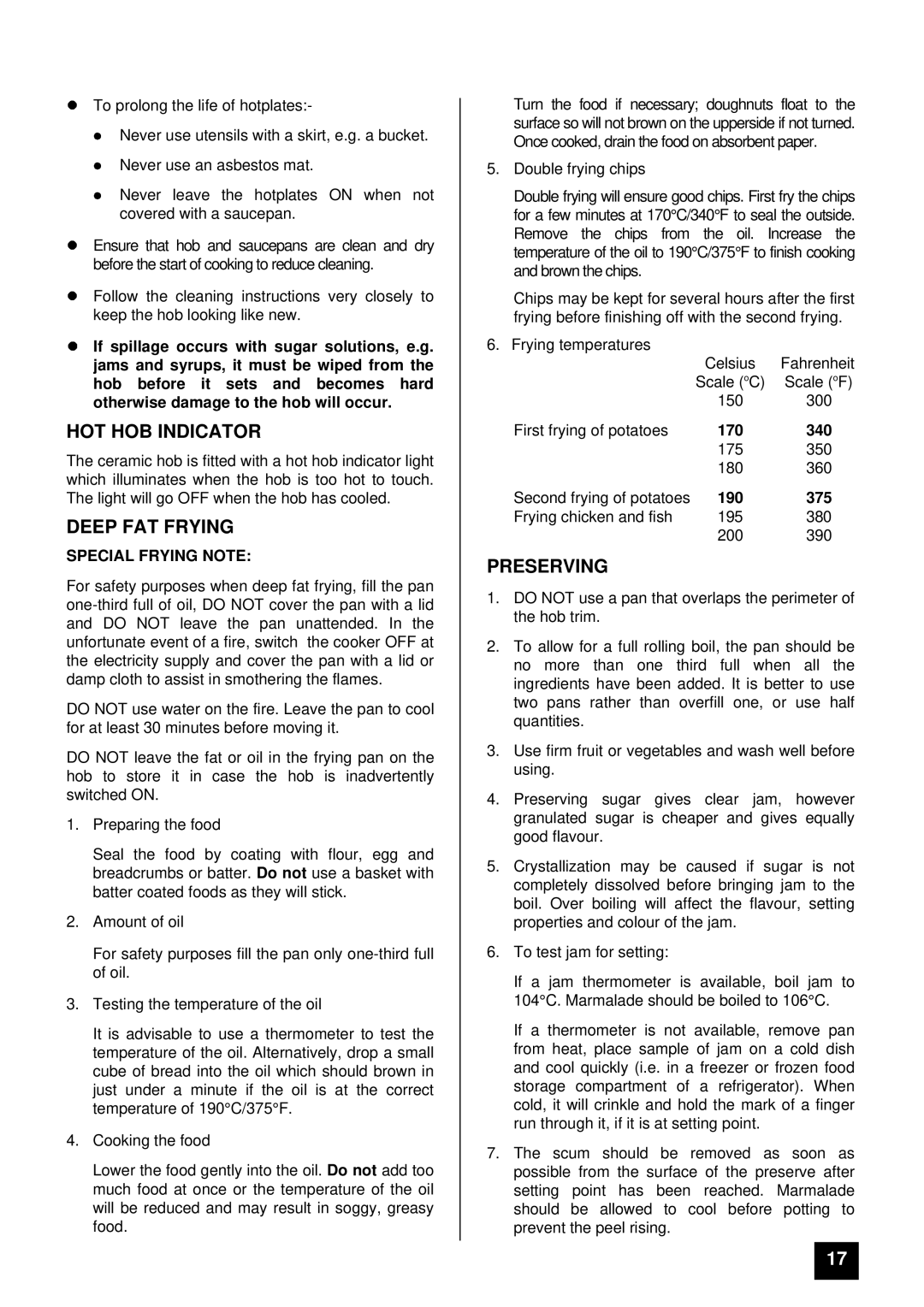
lTo prolong the life of hotplates:-
Never use utensils with a skirt, e.g. a bucket.
lNever use an asbestos mat.
Never leave the hotplates ON when not covered with a saucepan.
Ensure that hob and saucepans are clean and dry before the start of cooking to reduce cleaning.
Follow the cleaning instructions very closely to keep the hob looking like new.
If spillage occurs with sugar solutions, e.g. jams and syrups, it must be wiped from the hob before it sets and becomes hard otherwise damage to the hob will occur.
HOT HOB INDICATOR
The ceramic hob is fitted with a hot hob indicator light which illuminates when the hob is too hot to touch. The light will go OFF when the hob has cooled.
DEEP FAT FRYING
SPECIAL FRYING NOTE:
For safety purposes when deep fat frying, fill the pan
DO NOT use water on the fire. Leave the pan to cool for at least 30 minutes before moving it.
DO NOT leave the fat or oil in the frying pan on the hob to store it in case the hob is inadvertently switched ON.
1.Preparing the food
Seal the food by coating with flour, egg and breadcrumbs or batter. Do not use a basket with batter coated foods as they will stick.
2.Amount of oil
For safety purposes fill the pan only
3.Testing the temperature of the oil
It is advisable to use a thermometer to test the temperature of the oil. Alternatively, drop a small cube of bread into the oil which should brown in just under a minute if the oil is at the correct temperature of 190°C/375°F.
4.Cooking the food
Lower the food gently into the oil. Do not add too much food at once or the temperature of the oil will be reduced and may result in soggy, greasy food.
Turn the food if necessary; doughnuts float to the surface so will not brown on the upperside if not turned. Once cooked, drain the food on absorbent paper.
5.Double frying chips
Double frying will ensure good chips. First fry the chips for a few minutes at 170°C/340°F to seal the outside. Remove the chips from the oil. Increase the temperature of the oil to 190°C/375°F to finish cooking and brown the chips.
Chips may be kept for several hours after the first frying before finishing off with the second frying.
6.Frying temperatures
| Celsius | Fahrenheit |
| Scale (oC) Scale (oF) | |
| 150 | 300 |
First frying of potatoes | 170 | 340 |
| 175 | 350 |
| 180 | 360 |
Second frying of potatoes | 190 | 375 |
Frying chicken and fish | 195 | 380 |
| 200 | 390 |
PRESERVING
1.DO NOT use a pan that overlaps the perimeter of the hob trim.
2.To allow for a full rolling boil, the pan should be no more than one third full when all the ingredients have been added. It is better to use two pans rather than overfill one, or use half quantities.
3.Use firm fruit or vegetables and wash well before using.
4.Preserving sugar gives clear jam, however granulated sugar is cheaper and gives equally good flavour.
5.Crystallization may be caused if sugar is not completely dissolved before bringing jam to the boil. Over boiling will affect the flavour, setting properties and colour of the jam.
6.To test jam for setting:
If a jam thermometer is available, boil jam to 104°C. Marmalade should be boiled to 106°C.
If a thermometer is not available, remove pan from heat, place sample of jam on a cold dish and cool quickly (i.e. in a freezer or frozen food storage compartment of a refrigerator). When cold, it will crinkle and hold the mark of a finger run through it, if it is at setting point.
7.The scum should be removed as soon as possible from the surface of the preserve after setting point has been reached. Marmalade should be allowed to cool before potting to prevent the peel rising.
17
